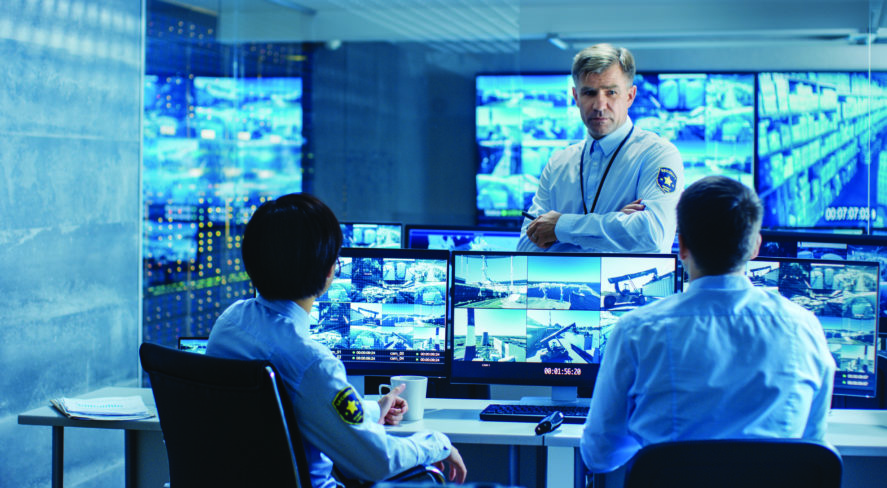At the Center of It All

Following a set of best practices can lead to a more effective GSOC

There recently has been a renewed focus on the heart of an organization’s security posture – the global security operations center (GSOC). Gone are the days when the GSOC was an afterthought on the road to securing a space. Today’s GSOCs are innovative, comfortable, functional, mobile at times and scalable. Enterprise organizations rely on their GSOC for business operations and, in times of emergency, a complete situational picture.
The goal of any GSOC is to monitor, assess, prevent and respond to a variety of threats and incidents. As technologies advance and trends develop, so do the strategies to meet this goal. Technology trends, such as data convergence, artificial intelligence (AI)/machine learning, and augmented reality are emerging as the future of GSOCs. These capabilities allow operators in command centers to achieve higher levels of security by promoting automation, awareness and rapid responses. A place where a variety of systems and solutions come together, the GSOC exists to provide a common operational picture, mitigate threats and promote enhanced communication during an incident.
Best practices for designing a GSOC must be taken into consideration to deliver the best possible results for security practitioners.
Consulting for Convergence
When a company decides to implement a GSOC or control room as part of its overall security plan, there are a number of ways the project can begin. Some know exactly what they want and the functionality they require, and they work directly with an integrator to accomplish their goals. Others, however, may need additional support in developing a vision for the safety of their facility. That is where consultants come in.
There are several ways in which a consultant can get involved in the GSOC development process. Often, the relationship begins with a comprehensive threat assessment of a facility that can reveal possible gaps in security. The next step in the process is evaluating the technology piece, which is where an integrator works side-by-side with a consulting firm to determine what is already in place, what is missing and what is needed.
A consultant may be tasked with creating a holistic approach for a security program. Many enterprise organizations are siloed, with IT, security and facility management each separate entities, and those silos must be broken down to create the kind of integrated environment that an effective security program requires. To do this, three elements must be addressed:
Policies and regulations
It is critical to develop policies and regulations to establish a consistent security program across the organization. These need to be well structured and clearly written.
People and procedures
Another important element is the people involved in the decisionmaking process. Answering questions about the various roles that human resources, IT, security and management play in the process is crucial to the success of a security plan. A consulting firm can use this information to begin to craft standard operating procedures (SOPs) and an operational flow that will help the organization be most effective.
Technology
This is one of the most complicated elements. Typically, enterprise security systems are built on the foundation of IP networks, requiring software that interfaces with operations. Working with specialty integrators is important in this step because of the need for extensive knowledge of the various pieces of technology that must be in place to formulate a common operational picture.
Taking each of these elements as they relate to a company’s organizational culture is critical to building a successful approach to security. Security can have a huge impact on an organization – and the effect can be negative if procedures are implemented in a haphazard manner with poor communication. That is where a consultant can come in and streamline the process.
Establishing procedures and communication is the first step toward delivering a GSOC that can meet the needs of an enterprise organization. This plays a major role in communicating to employees that they matter and are important to the company’s overall goal of building an environment that is positive and forward-thinking and that places people at the heart of its business.
Incorporating Technology
After identifying what a GSOC will achieve, an enterprise, with the help of its partners, must identify the technology that will be included in the command center. These spaces combine multiple security components, such as video, audio, access control, intrusion detection, and more. Facilities are also starting to include additional pieces, such as risk and threat assessment, employee travel, executive protection, and social media monitoring.
Video walls
When it comes to building a mission-critical GSOC, there is a reason why large-scale overview video walls that display many incoming data points are dominant. Uniform and integrated visual elements are imperative to the success of the GSOC, as operators and first responders require the most up-to-date and complete information regarding incoming security-related events. These visual displays must be able to aggregate a wide variety of devices and data into a single paneof-glass view, and at the heart of this mission are the monitors and displays that project the most relevant and critical information. As part of the video wall selection process, customers must work with their consultant and specialty integrator to decide how information will be communicated, such as with peak communication over Ethernet as opposed to traditional matrix switching. This provides organizations with flexible, scalable and cost-effective video walls and desktop integration.
AI/analytics
Innovative security systems are continuously gathering information and funneling massive amounts of data into a GSOC for analysis and response. AI can make the detection and communication of anomalies easier and enable faster and more effective responses. Powered by computer vision and machine learning, solutions that employ AI technology can highlight the 1-2 percent of video surveillance events that need attention from operators. These intelligent solutions can learn the difference between normal movement patterns and abnormal events in real time. This saves operators time and effort by only displaying the video that requires processing for increased situational awareness.
This type of technology is especially critical in GSOCs that manage a large number of video surveillance cameras at one time, a common issue that developed from an attempt to adjust to an evolving threat landscape. As risks have grown over the years, the traditional reaction has been to add more cameras. At some point, though, this starts to reduce efficiencies. The key is to apply a non-rules-based approach, where the analytics are not trained or told to look for any particular occurrence. Instead, by creating a statistical model of where pixels are at every moment in time, the technology can proactively identify an unusual movement or object and alert to a potential hazard. Operators in a GSOC can then facilitate the next level of action, if necessary.
Operator consoles
For maximum efficiency and situational awareness, the comfort of control room operators is crucial. If they are uncomfortable or distracted or in pain with a sore neck because of bad viewing angles, they can miss critical events or emergencies. One of the most significant elements contributing to control room comfort is a console. A console is not just a piece of furniture; it is the link between an operator and the technology he or she uses daily, thereby making it exceptionally important that operators utilize ergonomically correct consoles.
Data incorporation
Almost all of the latest devices and applications are producing big data. The amount of information available to command centers will only increase, and as analytics improve, effective data aggregation must follow. New GSOCs will include dashboards that can make sense of a large amount of information and put it in a digestible format to drive streamlined decision making.
Networking
The wall between cyber and physical security continues to crumble, as stakeholders realize the need for collaboration to protect the entire enterprise. Visualization platforms in command centers, such as video walls, will take advantage of the growing and valuable network architecture, resulting in less hardware, more redundancy and more reliability.
Improved communication
With decision makers spread out across buildings, campuses or even the world, GSOCs must include the ability to share real-time information about a situation with first responders and stakeholders, no matter where they may be, to enable them to make informed decisions and implement responses.
Bringing It All Together
Once best practices are established, a space is planned and technology is incorporated, it is time for the final piece of the puzzle: full integration. GSOC integrators and experts have a unique position in the industry to weigh in on the best possible configurations of furniture, hardware components and operator consoles. This can be a critical element, since line of sight issues must be addressed for operators to be able to make the best possible decisions for the security of the facility.
As more and more enterprise organizations realize the importance of having a well-designed, intelligent and integrated GSOC within their facilities, there will be a greater need for experts in the field to weigh in on best practices for building such infrastructure. Seeking out experts in this technology is vital to the success of a comprehensive security plan.
Dan Gundry (dgundry@vistacominc.com) is the director of sales and marketing for Vistacom.
This article originally appeared in the spring 2019 edition of SIA Technology Insights.
